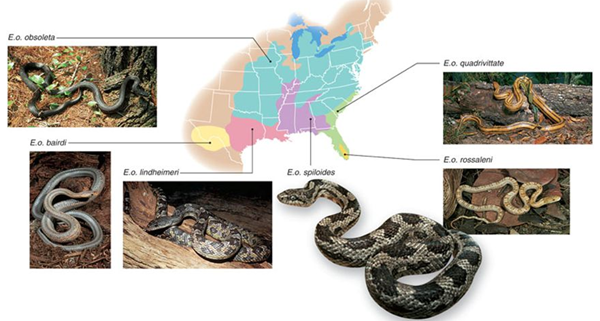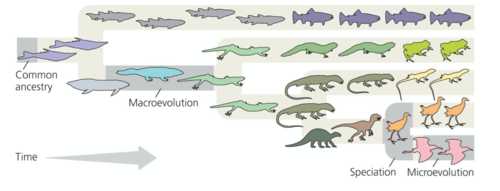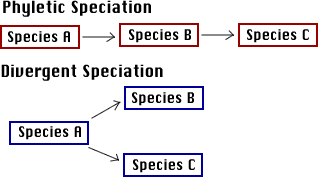PROCESS OF EVOLUTION
Microevolution
A population is all of the members of a single species
Population genetics studies the variation in alleles in a gene pool.
Microevolution studies small changes in alleles that occur within a population. Over time, these small changes can accumulate, resulting in major differences within the population.
What is the gene pool?
The gene pool refers to the total collection of genes and their different alleles (variants) present within a population of a particular species. It represents the genetic diversity of that population and includes all the variations of genes carried by the individuals within it.
Dogs have been artificially selected for certain traits, resulting in a wide range of breeds with very different characteristics. The gene pool refers to all of the alleles present in the dog populations and their variants.

Industrial Melanism
What caused the moths to shift in color?
A. Causes of Microevolution
1. Genetic Mutations
What is polymorphism?
The occurrence of multiple forms or phenotypes wihtin a single population of species.
Example: Rock pocket mice can range from dark brown to beige in color. A single mutation or allele change can alter the color.
Mutations can be harmful or beneficial.
*Relative Fitness- harmful genes may incur an advantage if the environment changes
2. Gene Flow
Alleles move among populations, increasing variation and prevents speciation.
Does gene flow increase or decrease diversity?
When individuals from one population migrate and interbreed with individuals of another population, they bring in their unique genetic variants (alleles).

Example of flow: Rat Snakes
Elaphe obsoleta obsoleta
Elaphe obsoleta lindheimeri
Elaphe obsoleta bairdi
Elaphe obsoleta quadrivatta
Elaphe obsoleta rossalleni
Elaphe obsoleta spiloides
These are considered subspecies.
3. Nonrandom Mating
What is nonrandom mating?
Individuals in a population choose their mates based on specific characteristics rather than randomly mating with any available individual.
Assortive mating
Individuals tend to mate with others who have similar phenotypes or genotypes.
Sexual selection
males compete for females. This can result in extreme characteristics, like the feathers of a peacock, or the larger sizes of males. (sexual dimorphism)
4. Genetic Drift
- Refers to changes in allele frequencies of a gene pool due to chance
The bottleneck effect is caused by a severe reduction in population, followed by a recovery. Reduces diversity
Example of bottleneck effect: Cheetahs experienced a bottleneck around 10,000 to 12,000 years ago, reducing their population to a small number of individuals.
The founder effect is an example of genetic drift where rare alleles occur in higher frequency; isolated populations
Example of founder effect: A small group of Amish settlers migrated to the United States in the 18th century, founding communities in Pennsylvania and other regions.
Types of Selection
1. Directional selection occurs when an extreme phenotype is favored; the distribution curve shifts that direction.
Example: Peppered Moths during Industrial Revolution:
- Scenario: Prior to the Industrial Revolution in England, the peppered moth population predominantly consisted of light-colored moths, which blended well with the light-colored tree bark, offering camouflage against predators.
- Environmental Change: With the onset of industrialization, tree bark became darker due to pollution, leading to a shift in the environment's appearance.
- Selection Pressure: Predation increased on lighter moths as they became more visible against the darker trees, while darker moths gained better camouflage and survival advantage.
- Effect: The population experienced directional selection favoring the darker moths.
- Outcome: Over time, the frequency of the darker moth variant increased significantly in the population, while the lighter variant decreased, reflecting the shift in the environment and the selective advantage of the darker coloration against predation.
2. Stabilizing selection occurs when extreme phenotypes are eliminated and the intermediate phenotype is favored.
Example: Birth Weight in Humans:
- Scenario: Consider the birth weight of human babies.
- Selection Pressure: Extremely low birth weights can pose health risks, while extremely high birth weights can also lead to complications for both the baby and the mother during childbirth.
- Effect: Babies with very low birth weights might struggle with health issues, while those with very high birth weights might face complications during delivery.
- Outcome: Stabilizing selection acts to favor intermediate birth weights that strike a balance between avoiding health risks associated with both extremes. As a result, the majority of human babies are born within a moderate weight range, as it provides the best chance of survival and reduces risks associated with either extreme.
3. Disruptive selection occurs when extreme phenotypes are favored and can lead to more than one distinct form.
Example: African Seedcrackers:
- Scenario: African seedcrackers are birds that feed on seeds with different shell sizes: small and large.
- Habitat: In an environment with two distinct seed sizes (small and large), the intermediate-sized seeds are less common.
- Selection Pressure: The birds with larger beaks are more adept at cracking the larger seeds, while those with smaller beaks are better suited for the smaller seeds.
- Effect: Intermediate beak sizes are less effective at cracking either size of seed, while the extreme beak sizes (large and small) are more efficient at handling their respective seed sizes.
- Outcome: Over time, the population diverges into two groups: one with larger beaks specialized for larger seeds and another with smaller beaks specialized for smaller seeds.
Macroevolution
Macroevolution refers to evolutionary changes that occur over large timescales, resulting in the formation of new species

What is a Species?
- a group of actually or potentially interbreeding populations
- a hybrid is an offspring of two distinct species, example: Liger, Mule
Reproductive Isolating Mechanisms
Prezygotic Isolating Mechanisms:
- Geographical Isolation: Populations are separated by physical barriers like mountains, rivers, or other geographical features.
- Ecological (Habitat) Isolation: Species occupy different habitats within the same area, reducing the chance of encountering each other.
- Temporal Isolation: Species breed at different times (seasons, day/night), preventing them from mating.
- Behavioral Isolation: Differences in courtship rituals, mating behaviors, or signals prevent mating between species.
- Mechanical Isolation: Structural differences prevent successful mating or pollination.
- Gametic Isolation: Sperm of one species may not be able to fertilize eggs of another species due to molecular incompatibility.
Postzygotic Isolating Mechanisms:
- Hybrid Inviability: Hybrid embryos do not develop properly and die before reaching maturity.
- Hybrid Sterility: Hybrids are viable but sterile, preventing gene flow between species (e.g., mules - offspring of horses and donkeys).
- Hybrid Breakdown: First-generation hybrids are viable and fertile, but subsequent generations of hybrids have reduced viability or fertility.
Modes of Speciation
Allopatric Speciation:
- Definition: Occurs when populations of the same species become geographically isolated, often due to physical barriers like rivers, mountains, or changes in habitat.
- Process: Isolation restricts gene flow between the separated populations, allowing them to diverge genetically over time through mutations, genetic drift, and natural selection.
- Outcome: Eventually, reproductive isolation occurs, and the populations become distinct species incapable of interbreeding.
Sympatric Speciation:
- Definition: Occurs when new species evolve within the same geographic area without physical isolation.
- Process: This can happen due to factors like polyploidy (increase in chromosome number), disruptive selection leading to the divergence of mating preferences or behaviors, or ecological specialization in a shared habitat.
- Outcome: Over time, these mechanisms lead to reproductive isolation between different groups within the same population, resulting in the formation of new species.
Speciation Process
Divergent Speciation:
- Definition: Divergent speciation refers to the process where a single species diverges into two or more descendant species.
- Process: It involves the splitting of a single ancestral population into distinct lineages due to factors like geographical isolation, different selective pressures, or ecological opportunities.
- Outcome: Over time, these separate lineages accumulate genetic differences, potentially leading to reproductive isolation and the formation of distinct species.
Phyletic Speciation:
- Definition: Phyletic speciation is a term sometimes used synonymously with anagenesis, which refers to the transformation of a single lineage over time.
- Process: In phyletic speciation, a species gradually evolves into a new species without branching or splitting into separate lineages. Instead, it's a gradual transformation of the entire population.
- Outcome: The original species undergoes significant evolutionary changes, potentially leading to the emergence of a new species. This evolutionary change happens within the continuous lineage without the formation of separate branches.

